Product Info Summary
| SKU: | M02702-1 |
|---|---|
| Size: | 100 μg/vial |
| Reactive Species: | Human, Mouse, Rat |
| Host: | Mouse |
| Application: | IHC, WB |
Customers Who Bought This Also Bought
Product info
Product Name
Anti-RbAp48 RBBP4 Antibody Picoband® (monoclonal, 9F3)
View all RBBP4/RbAp48 Antibodies
SKU/Catalog Number
M02702-1
Size
100 μg/vial
Form
Lyophilized
Description
Boster Bio Anti-RbAp48 RBBP4 Antibody Picoband® (monoclonal, 9F3) catalog # M02702-1. Tested in IHC, WB applications. This antibody reacts with Human, Mouse, Rat. The brand Picoband indicates this is a premium antibody that guarantees superior quality, high affinity, and strong signals with minimal background in Western blot applications. Only our best-performing antibodies are designated as Picoband, ensuring unmatched performance.
Storage & Handling
Store at -20˚C for one year from date of receipt. After reconstitution, at 4˚C for one month. It can also be aliquotted and stored frozen at -20˚C for six months. Avoid repeated freeze-thaw cycles.
Cite This Product
Anti-RbAp48 RBBP4 Antibody Picoband® (monoclonal, 9F3) (Boster Biological Technology, Pleasanton CA, USA, Catalog # M02702-1)
Host
Mouse
Contents
Each vial contains 4mg Trehalose, 0.9mg NaCl, 0.2mg Na2HPO4, 0.05mg NaN3.
Clonality
Monoclonal
Clone Number
9F3
Isotype
Mouse IgG1
Immunogen
A synthetic peptide corresponding to a sequence at the C-terminus of human RbAp48, identical to the related mouse sequence.
*Blocking peptide can be purchased. Costs vary based on immunogen length. Contact us for pricing.
Cross-reactivity
No cross-reactivity with other proteins.
Reactive Species
M02702-1 is reactive to RBBP4 in Human, Mouse, Rat
Reconstitution
Add 0.2ml of distilled water will yield a concentration of 500ug/ml.
Observed Molecular Weight
55 kDa
Calculated molecular weight
47.656kDa
Background of RBBP4/RbAp48
Histone-binding protein RBBP4 (also known as RbAp48, or NURF55) is a protein that in humans is encoded by the RBBP4 gene. This gene encodes a ubiquitously expressed nuclear protein which belongs to a highly conserved subfamily of WD-repeat proteins. It is present in protein complexes involved in histone acetylation and chromatin assembly. And it is part of the Mi-2 complex which has been implicated in chromatin remodeling and transcriptional repression associated with histone deacetylation. This encoded protein is also part of co-repressor complexes, which is an integral component of transcriptional silencing. It is found among several cellular proteins that bind directly to retinoblastoma protein to regulate cell proliferation. This protein also seems to be involved in transcriptional repression of E2F-responsive genes. Three transcript variants encoding different isoforms have been found for this gene.
Antibody Validation
Boster validates all antibodies on WB, IHC, ICC, Immunofluorescence, and ELISA with known positive control and negative samples to ensure specificity and high affinity, including thorough antibody incubations.
Application & Images
Applications
M02702-1 is guaranteed for IHC, WB Boster Guarantee
Assay Dilutions Recommendation
The recommendations below provide a starting point for assay optimization. The actual working concentration varies and should be decided by the user.
Western blot, 0.1-0.5μg/ml
Immunohistochemistry (Paraffin-embedded Section), 0.5-1μg/ml
Positive Control
WB: human Jurkat whole cell, rat thymus tissue, mouse spleen tissue,, human A549 whole cell, human Jurkat whole cell, human Hela whole cell, human PANC-1 whole cell
IHC: human intestinal cancer tissue, human placenta tissue, human mammary cancer tissue, human intestinal cancer tissue, human lung cancer tissue, mouse brain tissue, rat brain tissue
FCM: SiHa cell
Validation Images & Assay Conditions
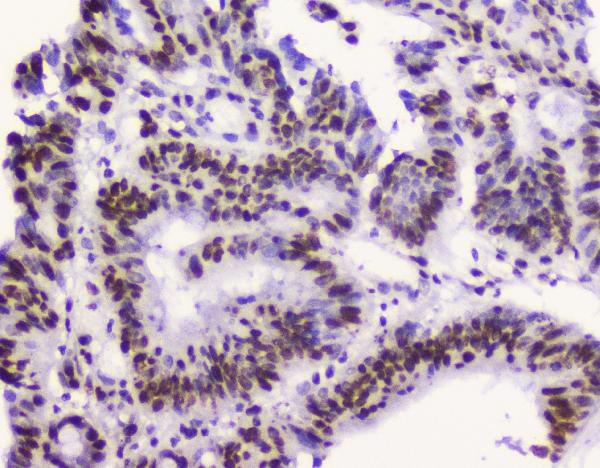
Click image to see more details
Figure 1. IHC analysis of RbAp48 using anti-RbAp48 antibody (M02702-1).
RbAp48 was detected in paraffin-embedded section of human intestinal cancer tissue. Heat mediated antigen retrieval was performed in citrate buffer (pH6, epitope retrieval solution) for 20 mins. The tissue section was blocked with 10% goat serum. The tissue section was then incubated with 2μg/ml mouse anti-RbAp48 Antibody (M02702-1) overnight at 4°C. Biotinylated goat anti-mouse IgG was used as secondary antibody and incubated for 30 minutes at 37°C. The tissue section was developed using Strepavidin-Biotin-Complex (SABC)(Catalog # SA1021) with DAB as the chromogen.
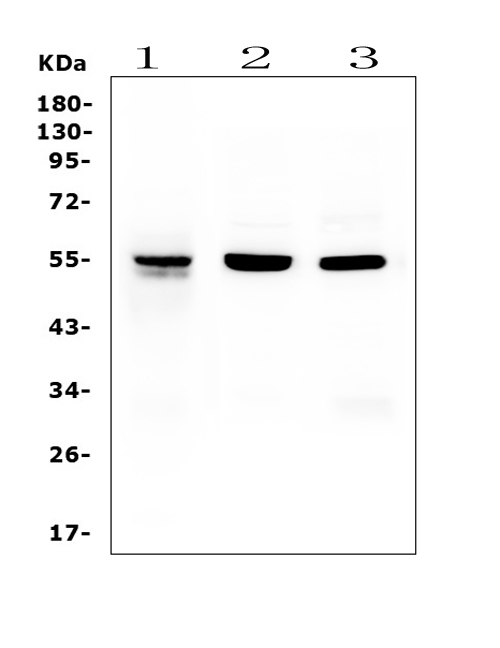
Click image to see more details
Figure 10. Western blot analysis of RbAp48 using anti-RbAp48 antibody (M02702-1).
Electrophoresis was performed on a 5-20% SDS-PAGE gel at 70V (Stacking gel) / 90V (Resolving gel) for 2-3 hours. The sample well of each lane was loaded with 50ug of sample under reducing conditions.
Lane 1: human Jurkat whole cell lysates
Lane 2: rat thymus tissue lysates
Lane 3: mouse spleen tissue lysates
After Electrophoresis, proteins were transferred to a Nitrocellulose membrane at 150mA for 50-90 minutes. Blocked the membrane with 5% Non-fat Milk/ TBS for 1.5 hour at RT. The membrane was incubated with mouse anti-RbAp48 antigen affinity purified monoclonal antibody (Catalog # M02702-1) at 0.5 μg/mL overnight at 4°C, then washed with TBS-0.1%Tween 3 times with 5 minutes each and probed with a goat anti-mouse IgG-HRP secondary antibody at a dilution of 1:10000 for 1.5 hour at RT. The signal is developed using an Enhanced Chemiluminescent detection (ECL) kit (Catalog # EK1001) with Tanon 5200 system. A specific band was detected for RbAp48 at approximately 55KD. The expected band size for RbAp48 is at 48KD.
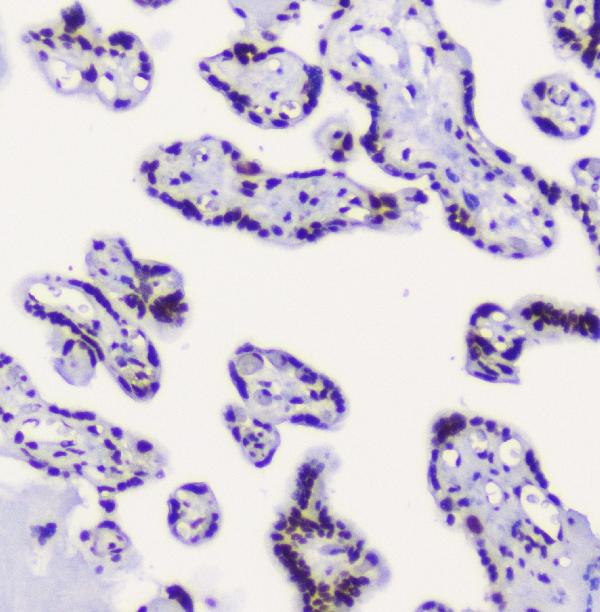
Click image to see more details
Figure 2. IHC analysis of RbAp48 using anti-RbAp48 antibody (M02702-1).
RbAp48 was detected in paraffin-embedded section of human placenta tissue . Heat mediated antigen retrieval was performed in citrate buffer (pH6, epitope retrieval solution) for 20 mins. The tissue section was blocked with 10% goat serum. The tissue section was then incubated with 2μg/ml mouse anti-RbAp48 Antibody (M02702-1) overnight at 4°C. Biotinylated goat anti-mouse IgG was used as secondary antibody and incubated for 30 minutes at 37°C. The tissue section was developed using Strepavidin-Biotin-Complex (SABC)(Catalog # SA1021) with DAB as the chromogen.
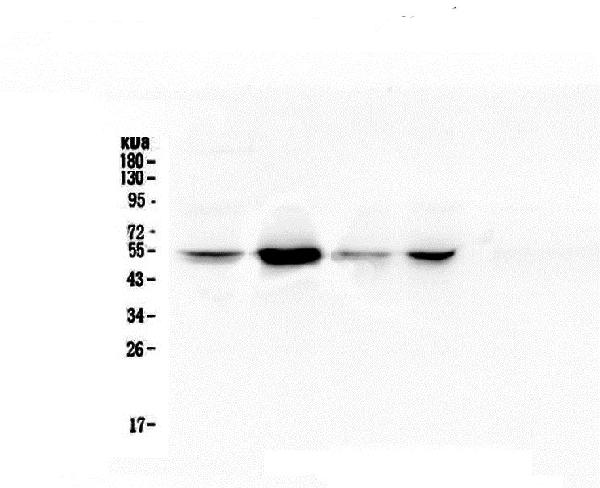
Click image to see more details
Figure 3. Western blot analysis of RbAp48 using anti-RbAp48 antibody (M02702-1).
Electrophoresis was performed on a 10% SDS-PAGE gel at 70V (Stacking gel) / 90V (Resolving gel) for 2-3 hours. The sample well of each lane was loaded with 50ug of sample under reducing conditions.
Lane 1: human A549 whole cell lysate,
Lane 2: human Jurkat whole cell lysate,
Lane 3: human Hela whole cell lysate,
Lane 4: human PANC-1 whole cell lysate.
After Electrophoresis, proteins were transferred to a Nitrocellulose membrane at 150mA for 50-90 minutes. Blocked the membrane with 5% Non-fat Milk/ TBS for 1.5 hour at RT. The membrane was incubated with mouse anti-RbAp48 antigen affinity purified monoclonal antibody (Catalog # M02702-1) at 0.5 μg/mL overnight at 4°C, then washed with TBS-0.1%Tween 3 times with 5 minutes each and probed with a goat anti-mouse IgG-HRP secondary antibody at a dilution of 1:10000 for 1.5 hour at RT. The signal is developed using an Enhanced Chemiluminescent detection (ECL) kit (Catalog # EK1001) with Tanon 5200 system.
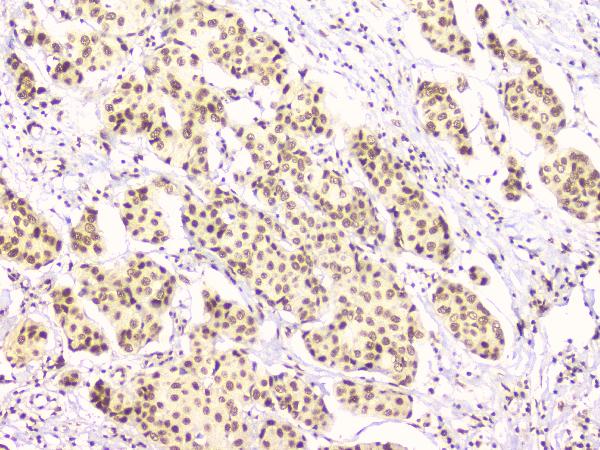
Click image to see more details
Figure 4. IHC analysis of RbAp48 using anti-RbAp48 antibody (M02702-1).
RbAp48 was detected in paraffin-embedded section of human mammary cancer tissues. Heat mediated antigen retrieval was performed in citrate buffer (pH6, epitope retrieval solution) for 20 mins. The tissue section was blocked with 10% goat serum. The tissue section was then incubated with 1μg/ml mouse anti-RbAp48 Antibody (M02702-1) overnight at 4°C. Biotinylated goat anti-mouse IgG was used as secondary antibody and incubated for 30 minutes at 37°C. The tissue section was developed using Strepavidin-Biotin-Complex (SABC)(Catalog # SA1021) with DAB as the chromogen.
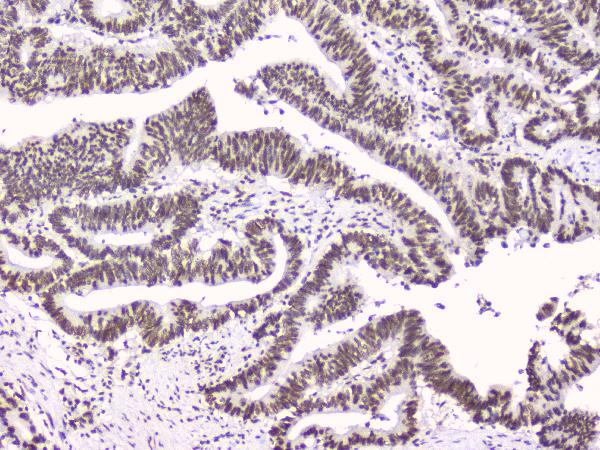
Click image to see more details
Figure 5. IHC analysis of RbAp48 using anti-RbAp48 antibody (M02702-1).
RbAp48 was detected in paraffin-embedded section of human intestinal cancer tissues. Heat mediated antigen retrieval was performed in citrate buffer (pH6, epitope retrieval solution) for 20 mins. The tissue section was blocked with 10% goat serum. The tissue section was then incubated with 1μg/ml mouse anti-RbAp48 Antibody (M02702-1) overnight at 4°C. Biotinylated goat anti-mouse IgG was used as secondary antibody and incubated for 30 minutes at 37°C. The tissue section was developed using Strepavidin-Biotin-Complex (SABC)(Catalog # SA1021) with DAB as the chromogen.
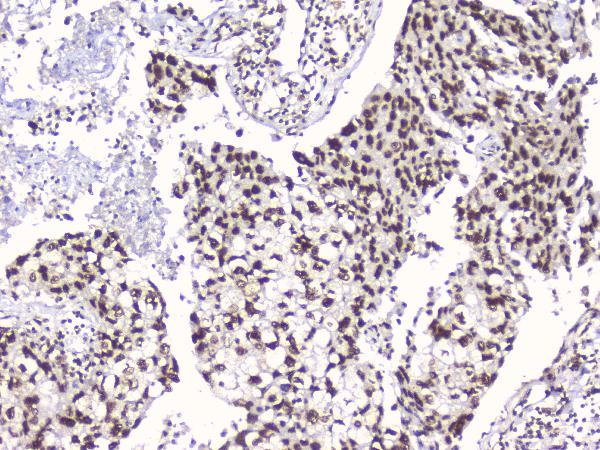
Click image to see more details
Figure 6. IHC analysis of RbAp48 using anti-RbAp48 antibody (M02702-1).
RbAp48 was detected in paraffin-embedded section of human lung cancer tissues. Heat mediated antigen retrieval was performed in citrate buffer (pH6, epitope retrieval solution) for 20 mins. The tissue section was blocked with 10% goat serum. The tissue section was then incubated with 1μg/ml mouse anti-RbAp48 Antibody (M02702-1) overnight at 4°C. Biotinylated goat anti-mouse IgG was used as secondary antibody and incubated for 30 minutes at 37°C. The tissue section was developed using Strepavidin-Biotin-Complex (SABC)(Catalog # SA1021) with DAB as the chromogen.
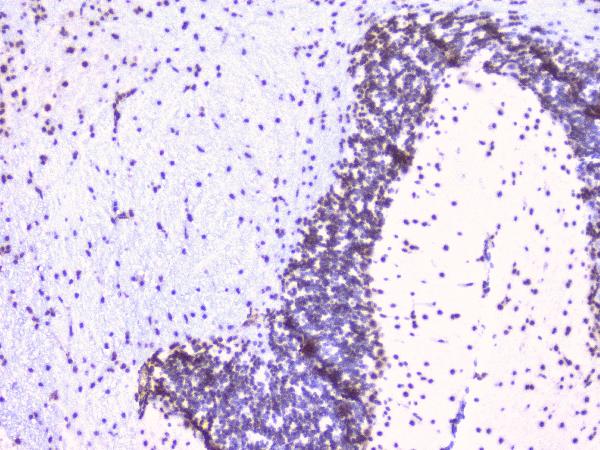
Click image to see more details
Figure 7. IHC analysis of RbAp48 using anti-RbAp48 antibody (M02702-1).
RbAp48 was detected in paraffin-embedded section of mouse brain tissues. Heat mediated antigen retrieval was performed in citrate buffer (pH6, epitope retrieval solution) for 20 mins. The tissue section was blocked with 10% goat serum. The tissue section was then incubated with 1μg/ml mouse anti-RbAp48 Antibody (M02702-1) overnight at 4°C. Biotinylated goat anti-mouse IgG was used as secondary antibody and incubated for 30 minutes at 37°C. The tissue section was developed using Strepavidin-Biotin-Complex (SABC)(Catalog # SA1021) with DAB as the chromogen.
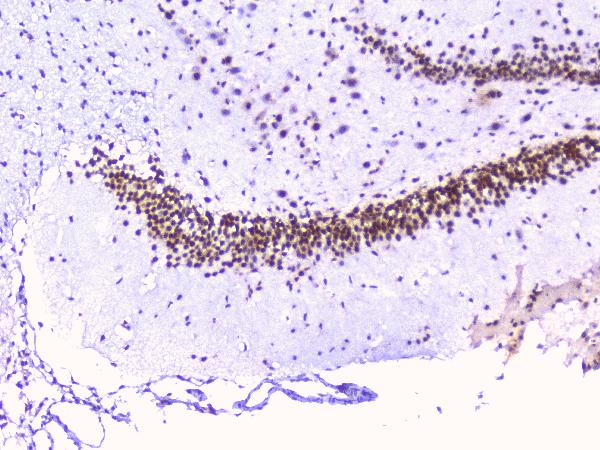
Click image to see more details
Figure 8. IHC analysis of RbAp48 using anti-RbAp48 antibody (M02702-1).
RbAp48 was detected in paraffin-embedded section of rat brain tissues. Heat mediated antigen retrieval was performed in citrate buffer (pH6, epitope retrieval solution) for 20 mins. The tissue section was blocked with 10% goat serum. The tissue section was then incubated with 1μg/ml mouse anti-RbAp48 Antibody (M02702-1) overnight at 4°C. Biotinylated goat anti-mouse IgG was used as secondary antibody and incubated for 30 minutes at 37°C. The tissue section was developed using Strepavidin-Biotin-Complex (SABC)(Catalog # SA1021) with DAB as the chromogen.
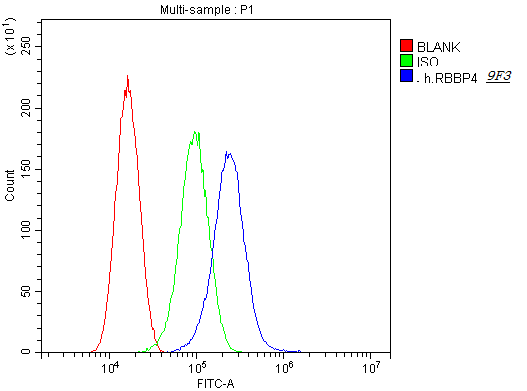
Click image to see more details
Figure 9. Flow Cytometry analysis of SiHa cells using anti-RbAp48 antibody (M02702-1).
Overlay histogram showing SiHa cells stained with M02702-1 (Blue line).The cells were blocked with 10% normal goat serum. And then incubated with mouse anti-RbAp48 Antibody (M02702-1,1μg/1x106 cells) for 30 min at 20°C. DyLight®488 conjugated goat anti-mouse IgG (BA1126, 5-10μg/1x106 cells) was used as secondary antibody for 30 minutes at 20°C. Isotype control antibody (Green line) was rabbit IgG (1μg/1x106) used under the same conditions. Unlabelled sample (Red line) was also used as a control.
Protein Target Info & Infographic
Gene/Protein Information For RBBP4 (Source: Uniprot.org, NCBI)
Gene Name
RBBP4
Full Name
Histone-binding protein RBBP4
Weight
47.656kDa
Superfamily
WD repeat RBAP46/RBAP48/MSI1 family
Alternative Names
Histone-binding protein RBBP4; Chromatin assembly factor 1 subunit C; CAF-1 subunit C; Chromatin assembly factor I p48 subunit; CAF-I 48 kDa subunit; CAF-I p48; Nucleosome-remodeling factor subunit RBAP48; Retinoblastoma-binding protein 4; RBBP-4; Retinoblastoma-binding protein p48; RBBP4; RBAP48 RBBP4 NURF55, RBAP48, lin-53 RB binding protein 4, chromatin remodeling factor histone-binding protein RBBP4|CAF-1 subunit C|CAF-I 48 kDa subunit|CAF-I p48|MSI1 protein homolog|RBBP-4|chromatin assembly factor 1 subunit C|chromatin assembly factor I p48 subunit|chromatin assembly factor/CAF-1 p48 subunit|nucleosome-remodeling factor subunit RBAP48|retinoblastoma-binding protein 4|retinoblastoma-binding protein p48
*If product is indicated to react with multiple species, protein info is based on the gene entry specified above in "Species".For more info on RBBP4, check out the RBBP4 Infographic

We have 30,000+ of these available, one for each gene! Check them out.
In this infographic, you will see the following information for RBBP4: database IDs, superfamily, protein function, synonyms, molecular weight, chromosomal locations, tissues of expression, subcellular locations, post-translational modifications, and related diseases, research areas & pathways. If you want to see more information included, or would like to contribute to it and be acknowledged, please contact [email protected].
Specific Publications For Anti-RbAp48 RBBP4 Antibody Picoband® (monoclonal, 9F3) (M02702-1)
Hello CJ!
No publications found for M02702-1
*Do you have publications using this product? Share with us and receive a reward. Ask us for more details.
Recommended Resources
Here are featured tools and databases that you might find useful.
- Boster's Pathways Library
- Protein Databases
- Bioscience Research Protocol Resources
- Data Processing & Analysis Software
- Photo Editing Software
- Scientific Literature Resources
- Research Paper Management Tools
- Molecular Biology Software
- Primer Design Tools
- Bioinformatics Tools
- Phylogenetic Tree Analysis
Customer Reviews
Have you used Anti-RbAp48 RBBP4 Antibody Picoband® (monoclonal, 9F3)?
Submit a review and receive an Amazon gift card.
- $30 for a review with an image
0 Reviews For Anti-RbAp48 RBBP4 Antibody Picoband® (monoclonal, 9F3)
Customer Q&As
Have a question?
Find answers in Q&As, reviews.
Can't find your answer?
Submit your question




